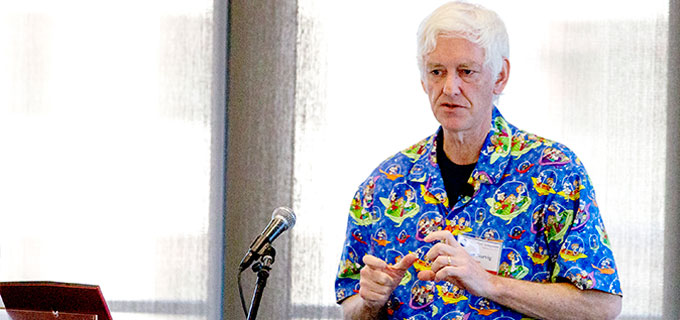NASA Event Brings Space Scientists To Stanford Engineering
Cutting edge thinkers traded ideas and updates at a symposium that was recorded and archived.
Could a computer analysis of dolphin communications serve as a model for deciphering possible future contacts with an extraterrestrial race?
That was but one of the questions that arose last week when dozens of space scientists gathered at Stanford Engineering for the NASA Innovative Advanced Concepts (NIAC) Symposium.
NIAC is part of NASA's Space Technology Mission Directorate. It offers fellowships to help scientists in academia, government and the private sector do preliminary studies of concepts that might lead to future missions or enhance our ability to travel in space.
Each year NIAC holds a symposium at which its fellows share ideas and updates. Last week’s event, hosted locally by NIAC fellow Marco Pavone, an assistant professor of aeronautics and astronautics at Stanford, afforded Stanford faculty and graduate students a chance to meet and mingle with some of the nation’s top space scientists.

Jay Falker, NIAC program executive, gives Marco Pavone, assistant professor of aeronautics and astronautics at Stanford, a certificate of appreciation during the 2014 NIAC Symposium on February 4. (Norbert von der Groeben)
The question about dolphin communication came after a presentation by Google Research Director Peter Norvig, one of several outside speakers at the event.
Norvig explained how the search engine company automated tasks such as language translation by sifting through masses of data to find signs printed in two languages. During the question period one attendee rose to ask whether this sort of machine learning approach could be used to decode messages that might one day be received from extraterrestrials.
When Norvig pointed out that machine learning relied on sifting through masses of data that did not in this case exist, the next questioner asked a follow up: would it be possible to create a database of dolphin sounds and gestures, and analyze that as a test bed for learning how another intelligence communicates.

Peter Norvig, director of research at Google, explains how the company automated tasks such as language translation by sifting through masses of data to find signs printed in two languages. (Norbert von der Groeben)
In the playful spirit of the event, Norvig allowed that video technology is already recording the movements of experimental rodents and that, if the technology were coupled with audio recordings, one could create a database of dolphin communications – a challenge he hurled back his audience of space scientists.
The three-day event, which featured one provocative talk after another, was recorded and webcast, and the presentations remain available at the archive site at http://www.livestream.com/niac2014. For more about NIAC and an agenda of the speakers and presentations visit https://www.signup4.net/Public/ap.aspx?EID=NIAC13E.
Tom Abate is associate director of communications at Stanford Engineering
Last modified Mon, 10 Feb, 2014 at 15:38


